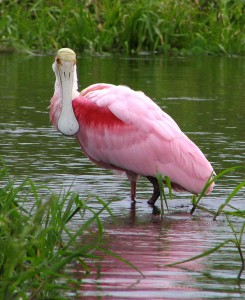Roger Tory Petersen called it, “one of the most breathtaking of the world’s weirdest birds,” and it was John James Audubon’s “rose-coloured curlew.” But the name that has s
tuck is roseate spoonbill. The roseate spoonbill is one of only six species of spoonbills in the world. It is the only one found in the New World and the only one with the fantastic pale pink to bright rose coloration.
These unique waders can stand nearly three feet tall and have a wingspan of more than four feet. Adults have a greenish featherless head and a large spatulate bill. Their necks are white with a tuft of pink feathers in breeding season. The white spills onto the back and breast but is quickly replaced with a pinkish, rosy hue. The color runs the gamut
from a pale pink to a brilliant rose pink. The saturation is diet dependant. The crustaceans the birds feed on, feed on algae that contain carotenes and other pigments that ultimately produce the color in the feathers. The roseate spoonbill ranges primarily from the Gulf States south to Chile and Argentina.
The collection of feathers for the millinery trade in the mid to late 1800s decimated spoonbill populations along with many egrets and herons. In the 1940s they were granted protection and had habitat set aside for them. They have been making a steady
comeback across most of their range.
The Everglades, however, once a stronghold for roseate spoonbills is once again seeing a precipitous decline in numbers. The culprit according to a piece by Rene Ebersole in Audubon Magazine is poor water management. Spoonbills in the Everglades were making steady recovery until around 1979 when wetlands were drained and ditched to create housing developments and roads. That was followed by “upgrading” the canal system and increasing pumping stations to divert water for agricultural purposes.
The spoonbill’s intuitive clock tells it that when water levels begin to fall in November and December, it is nesting time. In the natural order of things, when the eggs hatch about three weeks later, the fish and aquatic invertebrates that the spoonbill feeds on (and feeds to its chicks) will be concentrated in the shallow pools prevalent during the dry season. Unfortunately it has been common practice for water managers, working to keep those new developments dry, to open gates and spill water into the bay, which in turn floods the shallows where the spoonbills would be feeding making it impossible for the ad
ults to feed the chicks.
According to the article flood control and agriculture still take precedence over a balanced ecosystem, but the tide may be changing, at least enough to give the spoonbills a fighting chance.
Audubon Florida executive director Eric Draper noted that science was helping to inform water policy in the Everglades. The first phase of a new “spreader canal” that helps redistribute water into the bays and estuaries was opened in January and bridges are beginning to be punched through the Tamiami Trail, a road that forms the northern
boundary of the Everglades Park and acts as a dam keeping the natural flow of water out. Time will tell if these policies continue and if they will be enough to revive the dwindling spoonbill population.
The flip side of that equation is that in Louisiana, Mississippi, Texas and Georgia, Roseate spoonbills appear to be expanding their nesting range northward. I have seen pictures this summer of post-nest dispersal from Black Bayou National Wildlife Refuge in northeast Louisiana, Red Slough in southeastern Oklahoma and Huntington Beach State Park in North Carolina.

